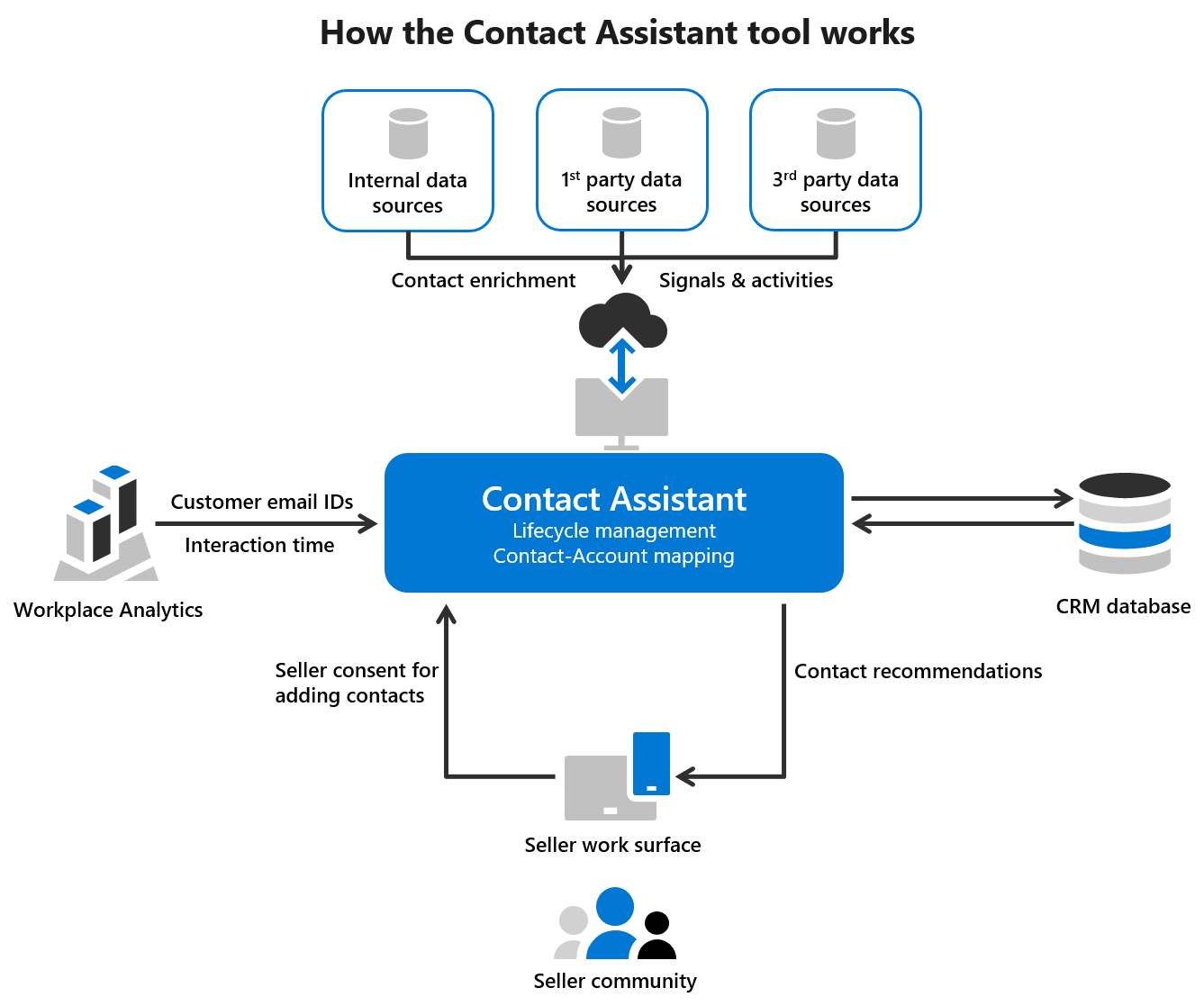This content has been archived, and while it was correct at time of publication, it may no longer be accurate or reflect the current situation at Microsoft.
For a salesperson, a contact list is like the air they breathe. It’s an invaluable sales asset that may contain current customers, leads, and contacts with whom they haven’t been in touch for a while and probably need to call.
The trouble is that keeping a contact list current while also receiving updates on a client’s status can be a headache.
Almost invariably, this means manually entering contact information from a business card or email into CRM. Everyone intends to keep up, but few do. This results in an incomplete list, or at worst a list containing contacts who have left their role or potential new contacts who have been missed.
“I’ve always relied on my Outlook contact list to keep up to date,” says Larry Kuhn, a Microsoft account technology strategist based in Chicago who works with global enterprise customers. “That really broke down when I needed to share contacts across our extended account team. That was upwards of 25 to 30 people, and that roster was constantly changing as people moved in or out of the organization. It was a problem going back years.”
Working with Microsoft Digital, Microsoft’s Contact Management team found a way to solve that perennial sales headache.
Now, the team has introduced a pilot tool that measures sellers’ time spent with external collaborators and converts relevant email and meeting metadata into an up-to-date contact list. Moreover, this feat was pulled off in a way that ensures the privacy of all those added to the list and employees as well.
How is this accomplished?
Each seller only receives a contact record for customers they are already collaborating with, which is private to them and unavailable to other sellers or people in the company.
“Sellers don’t enjoy spending time updating their contact lists, and sometimes don’t have time to hunt for changes to a client’s status,” says Rik Chowdhury, product manager with Microsoft’s Commercial Sales and Marketing group. “The result is that sellers have incomplete lists. This is a particular problem when there is an account transition, and a seller needs to hand contacts to someone else.”
[Learn how Microsoft transforms sales with AI-infused recommendations.]
The art of the possible
The Contact Management group took on the task of finding a better way.
The challenge was twofold: One, sift through the noisy digital static of interactions in emails and meetings and use that information to surface business contacts. And two, do so in a way that protected everyone’s privacy.

“We started with Workplace Analytics,” says Shailendra Hegde, a director for the Workplace Analytics product. “Workplace Analytics uses digital exhaust to generate insights. When you send an email or host a meeting, Workplace Analytics uses the header information to create a relationship and context graph. It asks, ‘Who sent the email to whom? At what point was it sent? How many other people were in that email? What external domains were there? What was the duration of the meeting and what time zone was the meeting set up in?’ It doesn’t read anything beyond the subject line, just the metadata of the email exchange.”
With that, the new contact tool—called Contact Assistant—uses Workplace Analytics to find key contacts by identifying traits such as time spent with the client, the apparent importance of the contact, and more. By reading only the metadata within a message, and not the content, privacy is protected, making sellers much more comfortable with the solution. Only actual business contacts migrate to the contact list, not personal ones.
We thought it might be a hard sell. But we were barely five minutes into our first Teams presentation when we started to see comments in the chat window with things like, ‘How do I sign up for this? When can I start? This looks great!’ It was really good to feel like we were bringing something to people where they immediately saw the value.
-Irina Chemerys, senior business program manager
Additionally, the privacy rules built into the Microsoft Dynamics 365 contact tool are flexible enough to adhere to privacy rules that vary by geography and are even stringent enough for the tough European GDPR standard.
Contact Assistant also augments the email of the contacts obtained from the metadata with other relevant contact attributes from first- and third-party data sources to build a complete contact profile that’s presented to the seller.
While Contact Assistant does all the work of extraction and enrichment of contact attributes, it allows the user to control migrating contacts to Microsoft Dynamics 365. This is particularly useful if the seller has more recent information on a contact—they can easily edit a specific field or block the contact altogether.
It helps my team stay more coordinated. It’s really easy now to make sure I have the right contact tagged in our contact list. I don’t spend time anymore digging through my contact list and forwarding Outlook contacts to other people on my team.
-Larry Kuhn, account technology strategist
In practice, the contact tool doesn’t bombard a seller with emails or other notifications about changes to the contact list. Instead, it presents within Microsoft Dynamics 365 a continually refreshed contact list, with flags notifying a seller about significant additions or changes.
“Now, if you’re engaging with midlevel managers with a company, and there is a senior-level person also involved, you will get an automatic recommendation that says, ‘Hey, maybe you should get in touch with this person too.’ That is the art of the possible,” Chowdhury says.
Turns out, a better contact list is an easy sell
Still, team members were a little nervous about presenting the pilot program to their first group of potential users.

“We thought it might be a hard sell,” says Irina Chemerys, senior business program manager for Microsoft’s Field Engagement and Delivery team. “But we were barely five minutes into our first Teams presentation when we started to see comments in the chat window with things like, ‘How do I sign up for this? When can I start? This looks great!’ It was really good to feel like we were bringing something to people where they immediately saw the value.”
For sellers like Kuhn, having a contact list that is always current and relevant is something of a miracle.
“It helps my team stay more coordinated,” Kuhn says. “It’s really easy now to make sure I have the right contact tagged in our contact list. I don’t spend time anymore digging through my contact list and forwarding Outlook contacts to other people on my team.
“It also helps avoid having to call or email contacts and ask them if there is another person in their organization I should be in touch with, or who has changed roles. They usually indulge me, but that is a real imposition on their time.”
COVID-19 makes a contact list more important than ever
It seems like everything these days is seeing an impact from COVID-19, and managing contacts is no exception.
“Physical interactions, meetings, conferences—all those things that help you stay up to date with contacts—have kind of gone out the window,” Kuhn says. “That makes it much more difficult to stay abreast of changes with key contacts. It’s much more important that all your contacts are in sync so you stay up to date.”
The new contact tool is another example of Microsoft’s effort to always put the customer first, says Amy Richards, a business program manager for the Customer and Partner Experience (CPE) team.
“Customer centricity is at the heart of everything we do,” Richards says. “How can we be customer-centric if we don’t know how to reach those customers? Granted, I work for a customer experience organization so that’s my focus. But the change in the company is dramatic. I’ve never seen so many people across business and engineering roles at the same table working toward helping the sellers.”
Managing contacts is a challenge that’s experienced by a lot of companies. If we can solve this at Microsoft scale, then I’m sure it can be solved for everybody else.
-Shailendra Hegde, a director for the Workplace Analytics team
Next steps for the contact management tool include rolling it out to a wider audience of Microsoft sellers. From an engineering standpoint, the goal is to create a more graphically intuitive contact dashboard give users at-a-glance updates on contacts.
“At the end of the day, we are harnessing the power of everyday collaboration insights to help our sellers sell well,” says Shailendra Hegde, a director of the Workplace Analytics team at Microsoft. “Managing contacts is a challenge that’s experienced by a lot of companies. If we can solve this at Microsoft scale, then I’m sure it can be solved for everybody else.”
Learn how Microsoft transforms sales with AI-infused recommendations.








